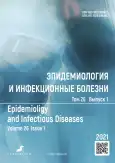Colloidal silicon dioxide in complex therapy of chronic opisthorchiasis
- Authors: Beskhlebova O.V.1, Karbysheva N.V.1, Nikonorova M.A.1, Umbetova K.T.2, Nemilostiva E..2
-
Affiliations:
- Altay State Medical University
- The First Sechenov Moscow State Medical University
- Issue: Vol 26, No 1 (2021)
- Pages: 37-43
- Section: Original study articles
- URL: https://journals.rcsi.science/1560-9529/article/view/101315
- DOI: https://doi.org/10.17816/EID101315
- ID: 101315
Cite item
Abstract
BACKGROUND: The uniqueness of the natural data of the region of Western Siberia, the peculiarities of the hydrological regime ensure the stable functioning of foci of opisthorchiasis with a morbidity rate exceeding the indicators in Russia by more than 2 times. The long-term, sometimes forced coexistence of the human body and helminths often leads to serious consequences, which affects the general level of health of the population of endemic territories. With opisthorchiasis, allergies develop, functional disorders of organs (liver, kidneys) and systems (immune, cardiovascular, respiratory, endocrine, digestion), as well as disorders of fat, carbohydrate, mineral metabolism and, in general, hormonal background.
The diversity and non-specificity of the clinical manifestations of opisthorchiasis expands the relevance of this problem and requires an increase in the effectiveness of care for such patients, which necessitates the use of enterosorbents.
AIMS: is to analyze the effectiveness of the use of the enterosorbent silicon dioxide colloidal (Polysorb MP) in complex therapy of chronic opisthorchiasis.
MATERIALS AND METHODS: 214 patients with the chronic phase of opisthorchiasis were analyzed (57.5% of women and 42.5% of men aged 18 to 55 years). The diagnosis of opisthorchiasis invasion was confirmed when helminth eggs were found in the feces (in 72.7%), eggs and/or marites of opisthorchiasis in duodenal contents (in 27.3%). All patients received standard therapy, which included three stages: preparatory; specific chemotherapy; rehabilitation. The complex therapy of patients in the observation group at the stage of pathogenetic preparation included the use of colloidal silicon dioxide.
Statistical processing was carried out using methods of variational statistics.
RESULTS: The use of the drug silicon dioxide colloidal as part of the complex therapy of chronic opisthorchiasis contributes to a faster improvement ― the relief of allergic manifestations (when using silicon dioxide colloidal amounted to 2.41 (from 2 to 3) days and a significantly significant decrease in total cholesterol and atherogenicity index was noted.
CONCLUSION: Silicon dioxide colloidal has shown efficacy in the treatment of patients with opisthorchiasis invasion and disorders in lipid metabolism. Patients noted excellent tolerability and absence of side effects.
The method of enterosorption can be recommended for the treatment of opisthorchiasis invasion in patients with lipid metabolism disorders.
Full Text
##article.viewOnOriginalSite##About the authors
Olga V. Beskhlebova
Altay State Medical University
Email: olg.deriglazova@yandex.ru
ORCID iD: 0000-0003-4561-1019
SPIN-code: 5033-5574
MD, Cand. Sci. (Med.)
Russian Federation, BarnaulNina V. Karbysheva
Altay State Medical University
Email: nvk80@rambler.ru
ORCID iD: 0000-0001-8320-3468
SPIN-code: 7917-7849
MD, Dr. Sci. (Med), Professor
Russian Federation, BarnaulMarina A. Nikonorova
Altay State Medical University
Author for correspondence.
Email: ma.nikulina@mail.ru
ORCID iD: 0000-0001-6621-9310
SPIN-code: 5396-5198
MD, Dr. Sci. (Med), Associate Professor
Russian Federation, BarnaulKarina T. Umbetova
The First Sechenov Moscow State Medical University
Email: karinasara@inbox.ru
ORCID iD: 0000-0003-0902-9267
SPIN-code: 3197-9205
MD, Dr. Sci. (Med.), Professor
Russian Federation, MoscowElena A. Nemilostiva
The First Sechenov Moscow State Medical University
Email: n.e.al@mail.ru
ORCID iD: 0000-0002-9164-5837
SPIN-code: 8018-1326
MD, Cand. Sci. (Med.), Associate Professor
Russian Federation, MoscowReferences
- On the state of sanitary and epidemiological welfare of the population in the Russian Federation in 2020: state report. Moscow: Federal Service for Supervision of Consumer Rights Protection and Human Well-Being; 2021. 256 p. (In Russ).
- Yurlova NI, Yadrenkina EN, Rastyazhenko NM, et al. Opisthorchiasis in Western Siberia: epidemiology and distribution in human, fish, snail, and animal populations. Parasitol Int. 2017;66(4):355–364. doi: 10.1016/j.parint.2016.11.017
- Verizhnikova LN, Aryamkina OL, Terentyeva NN. Somatic pathology in residents of Khanty-Mansi Autonomous Okrug ― Yugra. Bulletin of Siberian Medicine. 2020;19(2):13–19. (In Russ). doi: 10.20538/1682-0363-2020-2-13-19
- Golovach EA, Fedorova OS, Saprina TV, et al. Metabolic syndromes, carbohydrate and lipid metabolism disorders in helminthic infections: review of the literature. Bulletin of Siberian Medicine. 2018;17(4):187–198. (In Russ). doi: 10.20538/1682-0363-2018-4-187-198
- Degtyareva YuV, Vorob’eva EI, Karbysheva NV, et al. Changes in lipid metabolism in opisthorchiasis. Clinical Laboratory Diagnostics. 2007;(9):58–58a.
- Cukanov VV, Tonkih YuL, Gilyuk AV, et al. Opisthorchiasis: diagnostics, clinical manifestations, and management. Doctor.Ru. 2019;(8):49–53. (In Russ). doi: 10.31550/1727-2378-2019-163-8-49-53
- Cukanov VV, Gorchilova EG, Tonkih YuL, et al. Indicators of antioxidant status and oxidative stress in opisthorchiasis. Medical Council. 2021;(5):62–67. (In Russ). doi: 10.21518/2079-701X-2021-5-62-67
- Karbysheva NV, Bobrovskiy EA, Saldan IP, et al. Manifestation of liver pathology in chronic opisthorchiasis, issues of diagnosis and prevention. Epidemiology and Infectious Diseases. 2018;23(1):40–43.
- Tsukanov VV, Vasyutin AV, Tonkikh YuL, et al. Possibilities of using enterosorbent in combination therapy of patients with opisthorchiasis with skin syndrome. Medical Council. 2020;(5):70–76. doi: 10.21518/2079-701X-2020-5-70-76
- Howell CA, Markaryan E, Allgar V, et al. Enterosgel for the treatment of adults with acute diarrhoea in a primary care setting: a randomised controlled trial. BMJ Open Gastroenterol. 2019;6(1):e000287. doi: 10.1136/bmjgast-2019-000287
- Menshikova SV, Ketova GG, Popilov MA. The use of enterosorbent Polysorb MP (colloidal silicon dioxide) in the complex therapy of various pathological conditions in children. Modern Problems of Science and Education. 2016;(6):184.
Supplementary files






